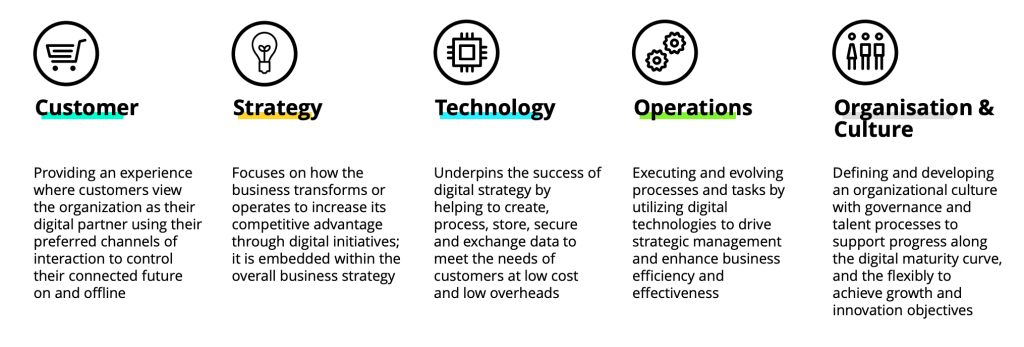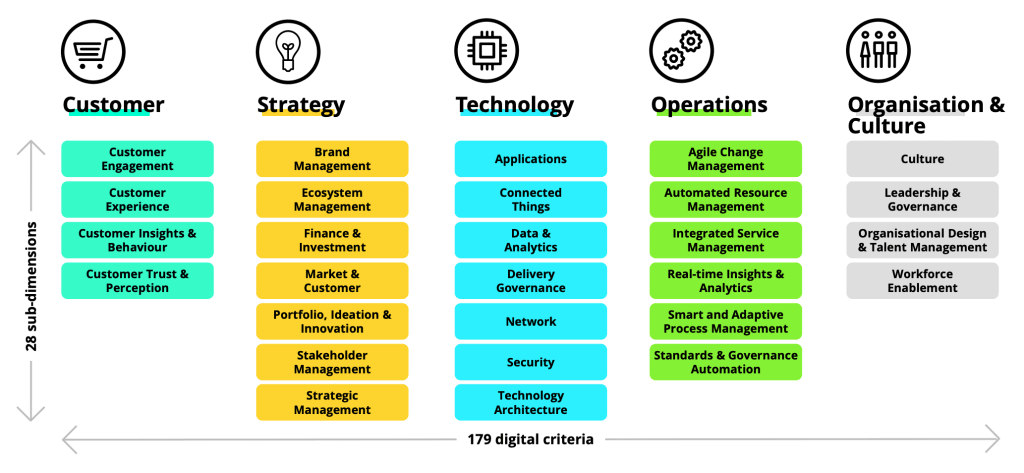Exploring the Impact of Digital Maturity on Digital Transformation

Innovation Management Framework-modeling
January 9, 2024
Understanding the Significance of Job Descriptions
February 5, 2024The extent of digital maturity plays a pivotal role in steering digital transformation endeavors, serving as a gauge for an organization’s ability to consistently comprehend and adjust to the ever-changing landscape of customer demands driven by ongoing technological advancements.
Companies that boast a heightened level of digital maturity tend to yield more favorable business outcomes, capitalizing on their previous investments and enhanced digitization efforts. This, in turn, leads to superior product offerings, streamlined processes, a forward-looking vision, and a more adaptive organizational culture. Organizations with higher digital maturity realize 3x higher revenue growth than those with low maturity.
Higher-maturity companies reported industry-leading revenue growth and profit margins.Percentage of respondents reporting metrics significantly above industry average, by level of digital maturity.

Widely Adopted Frameworks for Digital Maturity
Digital Maturity Models (DMMs) serve as frameworks designed to evaluate an organization’s existing digital maturity and offer a tailored roadmap for achieving digital strategy objectives, planning for expansion, and gauging success.
Numerous digital maturity frameworks are available, but three of the most frequently employed ones include:
Digital Maturity Model by Google and the Boston Consulting Group
Google’s digital maturity framework has four stages that focus on marketing and sales efforts.
- Nascent: In the early stage of digital maturity, the focus is to improve data quality by connecting data silos across departments. It requires strong leadership buy-in and stakeholder engagement.
- Emerging: Once the departments are well connected, the focus is on improving experiences, deploying new technology, and developing scalable strategies.
- Connected: In the connected stage, organizations leverage data-driven processes to improve productivity, employ offline and online data to drive sales, and support shared goals across the company.
- Multi-Moment: In the final stage, organizations aim to optimize their operational efficiency across all the channels, including sales, marketing, and IT services. Additionally, they use data-driven insights for their decision-making process.

Deloitte’s Digital Maturity Model
Deloitte and TM forum introduced the first pan-organizational digital model, covering five core business dimensions with 28 sub-dimensions and 179 criteria to assess the digital maturity of organizations, track the progress of their goals, and make impactful investments on their transformation journey.
The five dimensions are:
- Customer
- Strategy
- Technology
- Operations
- Organization & Culture


The TM forum added data as the sixth dimension to evaluate an organization’s strategic and operational ability to ethically and effectively use data and information assets to maximize business value.
The digital maturity levels according to Deloitte’s survey are:
- Higher Maturity: Organizations scoring in the top 25%
- Medium Maturity: Organizations in the middle 54%
- Lower Maturity: Organizations in the bottom 21% of digital technologies
BCG’s Digital Acceleration Index
BCG’s Digital Acceleration Index (DAI) is a powerful diagnostic tool that allows companies to assess their digital capabilities and compare their digital performance with the industry average, peers, and best-in-class digital leaders.
It also assesses their readiness to become a bionic company by merging new technologies with human capabilities to power growth, innovation, efficiency, and resilience.
According to BCG’s model the digital maturity levels are:

- Bionic companies: DAI score from 67-100
- Digitally Proficient: DAI score from 44-66
- Digital Laggards: DAI score of less than or equal to 43
Companies leverage DAI in the following two ways:
- In their initial phase of digital transformation, organizations use DAI to benchmark their digital maturity in 42 categories, such as customer journeys, digital supply chain, and marketing personalization. This early benchmarking delivers an exponential value over the course of their transformation journey and allows them to track their progress.
- In combination with deep-dive assessments, companies also use DAI to benchmark their broad capabilities, such as new digital growth, GTM capabilities, and future-ready tech functions. This combination provides them a competitive advantage across multiple performance indicators, such as time to market, cost efficiency, product quality, and customer satisfaction.



